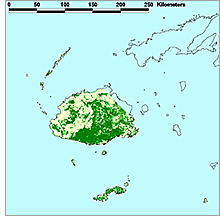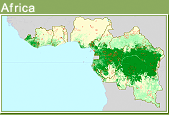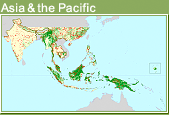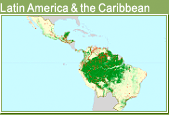Country details
Status of Tropical Forest Management 2005
Asia & the Pacific
Fiji

©UNEP-WCMC 2004
Timber is Fiji's third-largest export commodity and the sector still has considerable growth potential. However, land-use conflicts arising from the pattern of ownership have contributed to the degradation of the forest resource, particularly in natural forest, and have often been viewed as a major constraint to SFM. Other constraints include a lack of convincing evidence for the financial potential of the natural resource (and therefore the continued conversion of forests to various types of non-forest use), an inability to control the standards of logging in natural forests, and inadequate product supply and market research. Fiji's substantial mahogany plantation estate, if well managed and marketed, will be a significant driver of development.
Key points
- Because of the special conditions of land ownership there is no formal PFE, but some forests have equivalent status; an estimated 354,000 hectares may be regarded as a nominal PFE.
- None of the natural production forest (none of which is considered part of the PFE) is considered to be sustainably managed.
- Generally, the standard of logging is low. At least 55,000 hectares of protection PFE are estimated to be managed sustainably.
- Fiji has 55,000 hectares of plantation of the high-value species Swietenia macrophylla (mahogany) and there are plans to continue to expand this estate. Harvesting began in 2003; how the mahogany resource is managed and marketed will have a large bearing on the future success of the Fijian timber industry.
- Fiji also has a significant softwood plantation resource, which currently supplies about two-thirds of industrial timber.
- With some additions, Fiji continues to use its forest policy developed in 1950 as the basis of forestry, but implementation is guided by the priority now given to forest development based on exports. A review of the policy was completed recently.
- Apart from the conservation and expansion of forest cover, the forest policy focuses mainly on the efficient processing and manufacture of value-added products and training in forest industries.
- Fiji is a net exporter of wood products, including pine chips, sawnwood and wood-based panels. There is a small export trade of high-value finished products. The expansion of the export of these could make a significant contribution to the economy, particularly when mahogany timber is put on the international market.
- The forest area designated as 'protected' within IUCN categories I–IV is 3,000 hectares, although an area of 241,000 hectares has been broadly described as protection forest.

 Africa
Africa  Asia & the Pacific
Asia & the Pacific  Latin America & the Caribbean
Latin America & the Caribbean